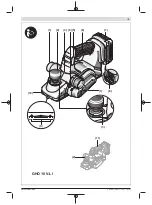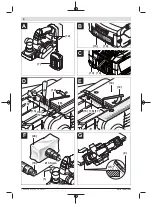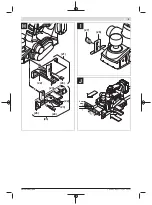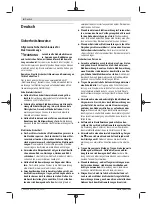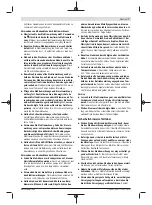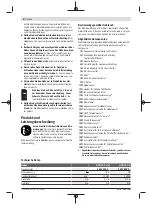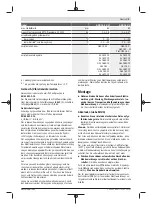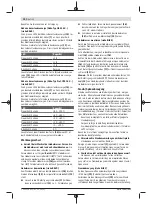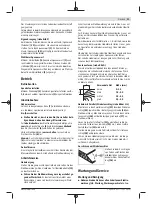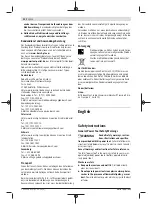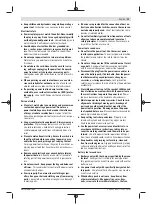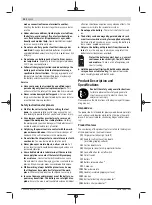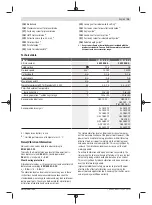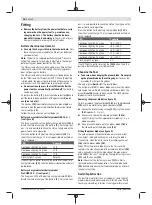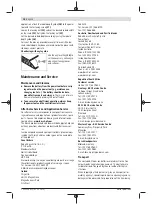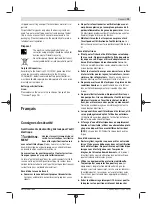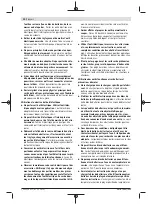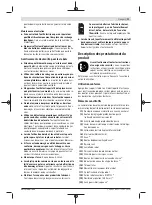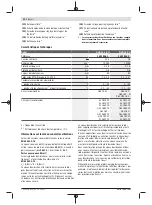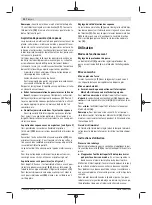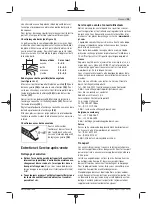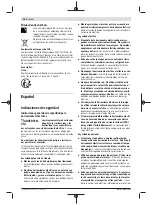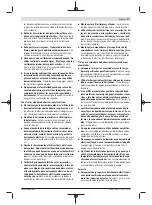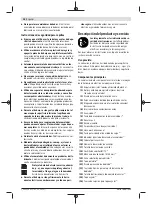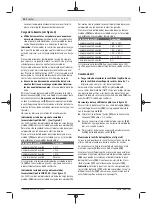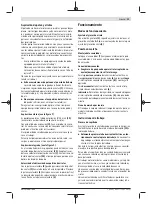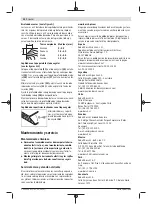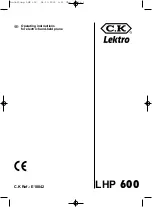
English |
17
tions and/or cause respiratory illnesses in the user or in
people in the near vicinity.
Certain dusts, such as oak or beech dust, are classified as
carcinogenic, especially in conjunction with wood treatment
additives (chromate, wood preservative). Materials contain-
ing asbestos may only be machined by specialists.
– Use a dust extraction system that is suitable for the ma-
terial wherever possible.
– Provide good ventilation at the workplace.
– It is advisable to wear a P2 filter class breathing mask.
The regulations on the material being machined that apply in
the country of use must be observed.
u
Avoid dust accumulation at the workplace.
Dust can
easily ignite.
Clean the chip ejector
(1)
regularly. Clean a clogged chip
ejector using a suitable tool, e.g. a piece of wood, com-
pressed air, etc.
u
Do not allow the chip ejector to come into contact with
your hands.
You may be injured by rotating parts.
Always use an external dust extraction device or chip/dust
bag to guarantee optimum suction.
External dust extraction (see figure F)
An extraction hose (dia. 35 mm)
(19)
(accessory) can be
connected to the chip ejector on either side.
Connect the dust extraction hose
(19)
to a dust extractor
(accessory). You will find an overview of how to connect to
various dust extractors at the end of these operating instruc-
tions.
The dust extractor must be suitable for the material being
worked.
When extracting dry dust that is especially detrimental to
health or carcinogenic, use a special dust extractor.
Self-generated dust extraction (see figure F)
A chip/dust bag (accessory)
(20)
can be used for smaller
jobs. Insert the dust bag nozzle of the chip/dust bag firmly
into the chip ejector
(1)
. Empty the chip/dust bag
(20)
at
regular intervals to maintain optimum dust collection.
Selectable chip ejector
Using the changeover lever,
(4)
the chip ejector can be
(1)
adjusted to the right or left. Push the changeover lever
(4)
all
the way towards the end position until it clicks into place.
The selected chip ejector direction is indicated by an arrow
symbol on the changeover lever
(4)
.
Operation
Operating modes
Setting the cutting depth
Using the knob
(2)
, the cutting depth can be continuously
adjusted between
0–1.6
mm with the aid of the cutting
depth scale
(3)
.
Start-up
Inserting the battery
Insert the charged battery
(7)
into the battery holder until it
is flush and you feel it engage.
Switching on/off
u
Make sure that you are able to press the On/Off switch
without releasing the handle.
To
start
the power tool,
first
press the lock-off button
(6)
,
then
press and hold the on/off switch
(6)
.
To
switch off
the power tool, release the on/off switch
(6)
.
Note:
For safety reasons, the on/off switch
(6)
cannot be
locked; it must remain pressed during the entire operation.
Run-out brake
An integrated run-out brake shortens the time the cutter
shafts keep running for after the power tool has been
switched off.
Practical advice
Planing Procedure
Set the required cutting depth and position the power tool
with the front section of the planer base plate
(10)
on the
workpiece.
u
Only bring the power tool into contact with the work-
piece when switched on.
Otherwise there is danger of
kickback if the cutting tool jams in the workpiece.
Switch on the power tool and guide it over the surface of the
workpiece, applying uniform feed.
To achieve high-quality surfaces, apply only a low feed rate
and exert pressure on the middle of the planer base plate.
For the processing of hard materials, such as hardwood, and
also when utilising the maximum planing width, set only a
low cutting depth and reduce the planer feed as appropriate.
Excessive feed reduces the quality of the surface finish and
can lead to the chip ejector quickly becoming blocked.
Only sharp planer blades achieve good cutting performance
and make the power tool last longer.
Chamfering edges (see figure G)
The V-grooves in the front of the planer base plate enable
quick and easy chamfering of workpiece edges. Select the V-
groove that corresponds to your chamfering width. Then po-
sition the planer with the V-groove onto the edge of the
workpiece and guide it along.
Groove used
Dimension a
(mm)
None
0–2.5
Small
1.5–4.0
Medium
2.0–4.5
Large
3.0–5.5
Planing with the Parallel/Angle Guide (see figures H–J)
Attach the parallel guide
(21)
or the angle guide
(25)
to the
power tool with the fastening screw
(24)
. Depending on the
Bosch Power Tools
1 609 92A 4PL | (21.02.2019)

